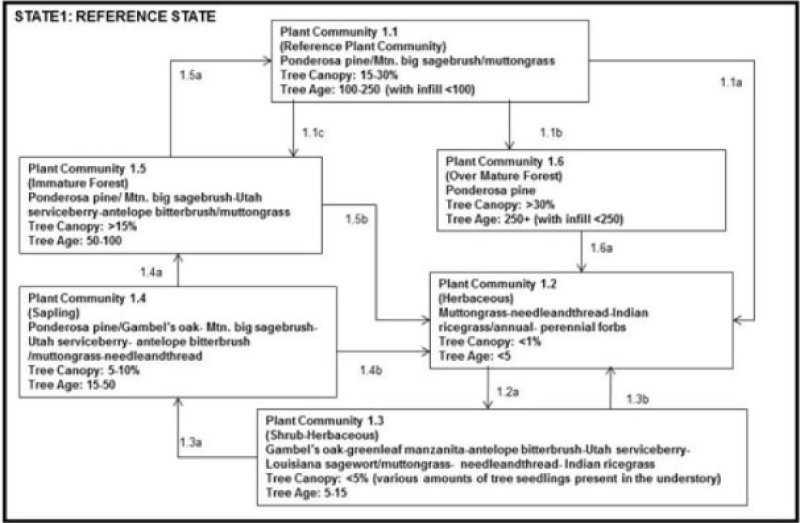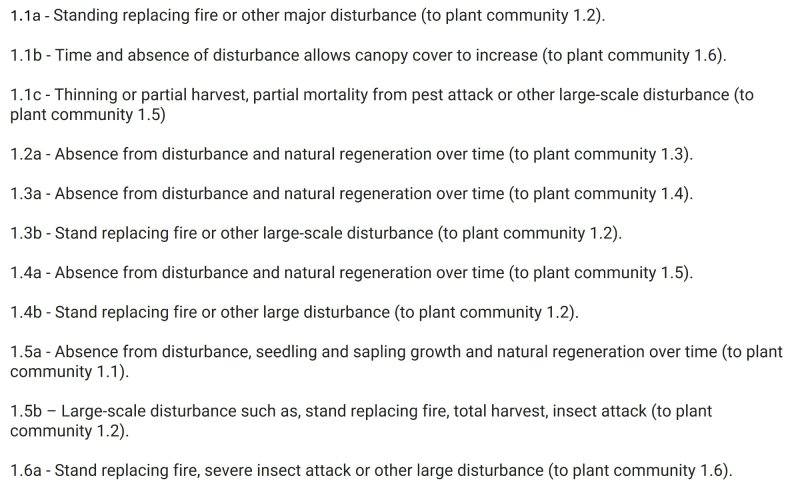Interpretations
Animal community
Livestock Interpretations:
This site is suited to cattle and sheep grazing during the summer and fall. Livestock will often concentrate on this site taking advantage of the shade and shelter offered by the tree overstory. Many areas are not used because of steep slopes or lack of adequate water. Attentive grazing management is required due to steep slopes and erosion hazard.
Grazing management should be keyed to palatable shrub and perennial grass production. Muttongrass is highly nutritious and remains palatable throughout the grazing season. Muttongrass is excellent forage for domestic livestock especially in the early spring. Muttongrass begins growth in late winter and early spring, which makes it available before many other forage plants. New plants of muttongrass are established entirely from seed and grazing practices should allow for ample seed production and seedling establishment.
Sandberg bluegrass is a widespread forage grass. It is one of the earliest grasses in the spring and is sought by domestic livestock and several wildlife species. Sandberg bluegrass is a palatable species, but its production is closely tied to weather conditions. It produces little forage in drought years, making it a less dependable food source than other perennial bunchgrasses.
Harvesting trees under a sound management program for can open up the tree canopy to allow increased production of understory species desirable for grazing.
Bottlebrush squirreltail is very palatable winter forage for domestic sheep of Intermountain ranges. Domestic sheep relish the green foliage. Overall, bottlebrush squirreltail is considered moderately palatable to livestock.
Sedge provides good to fair forage for domestic grazing. Pointleaf manzanita provides food and cover for livestock. Domestic goats prefer pointleaf manzanita browse. Utah serviceberry provides good browse for domestic sheep and domestic goats. In the spring, Utah serviceberry provides fair forage for cattle and good to excellent browse for domestic sheep and goats. Utah serviceberry provides good forage late in winter and in early spring, because it leafs out and blooms earlier than associated species. Mountain big sagebrush is eaten by domestic livestock but has long been considered to be of low palatability, and a competitor to more desirable species. Antelope bitterbrush is important browse for livestock. Domestic livestock and mule deer may compete for antelope bitterbrush in late summer, fall, and/or winter. Cattle prefer antelope bitterbrush from mid-May through June and again in September and October. Snowberry is readily eaten by all classes of livestock, particularly domestic sheep. Some livestock (domestic goats, sheep, and cattle) use it in spring, fall, and/or winter but rarely in the summer.
Stocking rates vary with such factors as kind and class of grazing animal, season of use and fluctuations in climate. Actual use records for individual sites, a determination of the degree to which the sites have been grazed, and an evaluation of trend in site condition offer the most reliable basis for developing initial stocking rates. Selection of initial stocking rates for given grazing units is a planning decision. This decision should be made ONLY after careful consideration of the total resources available, evaluation of alternatives for use and treatment, and establishment of objectives by the decisionmaker.
The forage value rating is not an ecological evaluation of the understory as is the range condition rating for rangeland. The forage value rating is a utilitarian rating of the existing understory plants for use by specific kinds of grazing animals.
Wildlife Interpretations:
This site has moderate value for mule deer during the summer and fall. Upland game species including rabbits, sage grouse, blue and ruffed grouse use it. Various songbirds, rodents, reptiles and associated predators natural to the area, also use it. Feral horses will use this site during the summer and fall. Manzanita provides food and cover for wildlife. Many frugivorous animals eat the berries, including blue grouse, Gambel's quail, mule deer, American black bears, coyotes and skunks. Palatability of manzanita is considered "low" for deer species. Manzanita stands are considered excellent cover for deer and desert bighorn sheep. Utah serviceberry is a very important species for mule deer in the Great Basin. Porcupines and desert bighorn sheep also use Utah serviceberry. Utah serviceberry fruit is preferred by many birds. It can be an important winter food for birds since berries stay on the shrub throughout the winter. Mountain big sagebrush is highly preferred and nutritious winter forage for mule deer and elk.
Mule deer, elk, and bighorn sheep utilize antelope bitterbrush extensively. Mule deer use of antelope bitterbrush peaks in September, when antelope bitterbrush may compose 91 percent of the diet. Winter use is greatest during periods of deep snow. Antelope bitterbrush seed is a large part of the diets of rodents, especially deer mice and kangaroo rats. Snowberry is an important forage species for deer and elk on high elevation summer ranges. Snowberry is frequently one of the first species to leaf out, making it a highly sought after food in the early spring. Curlleaf mountain mahogany provides food and cover for a variety of wildlife species. Curlleaf mountain mahogany is highly palatable to deer. A variety of small mammals consume curlleaf mountain mahogany seeds. Deer and elk make heavy use of muttongrass, especially in early spring when other green forage is scarce. Depending upon availability of other nutritious forage, deer may use muttongrass in all seasons. Muttongrass cures well and is an important fall and winter deer food in some areas. Sandberg bluegrass is desirable for pronghorn antelope and mule deer in the spring and preferable in the spring, summer, and fall for elk and desirable as part of their winter range. Bottlebrush squirreltail is a dietary component of several wildlife species. Bottlebrush squirreltail may provide forage for mule deer and pronghorn. Sedges have a high to moderate resource value for elk and a medium value for mule deer. Elk consume beaked sedge later in the growing season.
Hydrological functions
The hydrologic cover condition of this site is fair in a representative stand. The average runoff curve is about 60 for group B soils. Runoff is medium. Permeability is moderate.
Recreational uses
The trees on this site provide a welcome break in an otherwise open landscape. It has potential for hiking, cross-country skiing, camping, and deer and upland game hunting.
Wood products
The wood of ponderosa pine is valuable for lumber. Although no longer harvested, the oleoresin, or pitch, of ponderosa pine has been a source of turpentine in the past (Lanner, 1984).
PRODUCTIVE CAPACITY
This forestland community is of low site quality for tree production. Site index ranges from 65 to 77 (Table 21, SCS, 190-V-NFM Amend. 3; from Meyer, 1938. USDA Tech. Bull. 630).
Productivity Class: 4
CMAI*: 50 to 60 ft3/ac/yr;
3.5 to 4.5 m3/ha/yr.
Culmination is estimated to be at 100 years.
*CMAI: is the culmination of mean annual increment or highest average growth rate of the stand in the units specified.
Fuelwood Production: 30 to 35 cords per acre for stands averaging 50 to 60 feet in height and 90 years of age with a medium canopy cover. There are about 213,750 gross British Thermal Units (BTUs) heat content per cubic foot of ponderosa pine wood. Solid wood volume in a cord varies but usually ranges from 65 to 90 cubic feet. Assuming an average of 75 cubic feet of solid wood per cord, there are about 16 million BTUs of heat value in a cord of ponderosa pine wood.
Posts (7 foot): 25 to 50 per acre in stands of medium canopy.
Tree Volume per Acre: For stands averaging 60 feet in height and 90 years of age:
SITE INDEX 65 = 4050 cu ft
SITE INDEX 77 = 5050 cu ft
MANAGEMENT GUIDES AND INTERPRETATIONS
1. LIMITATIONS AND CONSIDERATIONS
a. Potential for sheet and rill erosion is moderate to severe depending on slope.
b. Moderate to severe equipment limitations on steeper slopes and moderate to severe equipment limitations on sites having extreme surface stoniness.
c. Proper spacing is the key to a well managed, multiple use and multi-product forest.
2. ESSENTIAL REQUIREMENTS
a. Adequately protect from wildfire.
b. Protect soils from accelerated erosion.
c. Apply proper grazing management.
3. SILVICULTURAL PRACTICES
a. Harvest cut selectively or in small patches size dependent upon site conditions) to enhance forage production.
1) Thinning and improvement cutting - Removal of poorly formed, diseased and low vigor trees for fuelwood.
2) Harvest cutting - Selectively harvest surplus trees to achieve desired spacing. Save large, healthy, full-crowned trees for cone (fruit) producers. Do not select only "high grade" trees during harvest.
3) Slash Disposal - broadcasting slash improves reestablishment of native understory herbaceous species and establishment of seeded grasses and forbs after tree harvest.
4) Spacing Guide - D+9
b. Prescription burning program to maintain desired canopy cover and manage site reproduction.
c. Fire hazard - Fire usually not a problem in well-managed, mature stands.
Other products
Rocky Mountain ponderosa pine, Pinus ponderosa var. scopulorum has migrated into the Great Basin following the ice ages by way of the Southern Rocky Mountains. Rocky Mountain ponderosa pine never attain the size of the typical variety (P. ponderosa var. ponderosa). The fascicles of this tree tend to have only two needles and the needles are shorter than the typical variety. The cones of Rocky Mountain ponderosa pine are also smaller then the typical variety (Lanner, 1984).
The wood of ponderosa pine is valuable for lumber. Although no longer harvested, the oleoresin, or pitch, of ponderosa pine has been a source of turpentine in the past. Pointleaf manzanita was an important food of some Southwest Native Americans. Utah serviceberry fruits were used by Native Americans and early European explorers in North America for food and medicine. Native Americans used big sagebrush leaves and branches for medicinal teas, and the leaves as a fumigant. Bark was woven into mats, bags and clothing.
Other information
Ponderosa pine is widely used for soil stabilization and watershed protection. Bareroot stock is used occasionally for planting on mine-spoils in the West. Bottlebrush squirreltail is tolerant of disturbance and is a suitable species for revegetation. Utah serviceberry has been used to revegetate big game winter range and for surface stabilization. It grows slowly from seed and therefore transplanting may be more successful than seeding for revegetation projects. Antelope bitterbrush has been used extensively in land reclamation. Antelope bitterbrush enhances succession by retaining soil and depositing organic material and in some habitats and with some ecotypes, by fixing nitrogen. Mountain snowberry is useful for establishing cover on bare sites and has done well when planted onto roadbanks. Curlleaf mountain mahogany may be planted to help stabilize soil in disturbed areas such as roadcuts and mine spoils.
| Common name |
Symbol |
Site index low |
Site index high |
CMAI low |
CMAI high |
Age of CMAI |
Site index curve code |
Site index curve basis |
Citation |
| ponderosa pine |
PIPOS
|
65 |
77 |
50 |
60 |
– |
– |
– |
|


